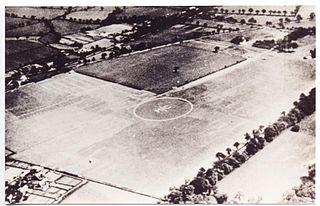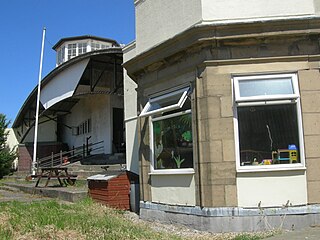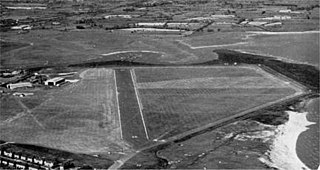
Archerfield Airport is a leased federal airport located in Archerfield, 11–12 km (6.8–7.5 mi) to the south of Brisbane, Queensland, Australia. For some time, it was the primary airport in Brisbane, but it is now the secondary airport. During World War II, it was used as a Royal Australian Air Force station. Airport traffic peaked in the 1980s. In December 2010, a development plan was released for public comment and included a new parallel runway.

Downsview Park(French: Parc Downsview) is a large urban park located in the Downsview neighbourhood of Toronto, Ontario, Canada. The park's name is officially bilingual due to it being federally owned and managed, and was first home to de Havilland Canada, an aircraft manufacturer, and later was a Canadian Forces base. The park still contains Downsview Airport. In 1999, the Government of Canada declared it as "Canada's first urban national park". However, unlike the Rouge National Urban Park in eastern Toronto, Downsview Park is managed by the federal Crown corporation Canada Lands Company rather than Parks Canada.

Downsview Airport, formerly IATA: YZD, ICAO: CYZD, was an airport located in Toronto, Ontario, Canada. An air field, then air force base, it has been a testing facility for Bombardier Aerospace from 1994. In 2018, Bombardier sold the facility to Northcrest Developments; in late 2023, Northcrest announced that industrial and airport operations would close by mid-2024, as redevelopment into commercial and residential properties moves forward. The airport was listed as closed March 7, 2024.
Barker Field was one of several airfields in the Yorkdale area of Toronto, Ontario, Canada.
Long Branch Aerodrome was an airfield located west of Toronto, Ontario and just east of Port Credit, now Mississauga, and was Canada's first aerodrome. The airport was opened by the Curtiss Flying School, part of the Curtiss Aeroplane and Motor Company, as a pilot training school in 1915. In 1917 the airport was run by the Royal Flying Corps (RFC), and then closed in 1919. It is recognized by the existence of Aviation Road in the Lakeview, Mississauga community and a historical plaque.
Toronto Aerodrome, also known as Canadian Air Express Airport, was an aerodrome located in Toronto, Ontario, Canada.
Canadian Forces Base Toronto is a former Canadian Forces base in Toronto, Ontario. The airfield is currently operated as Toronto / Downsview Airport.

Heston Aerodrome was an airfield located to the west of London, England, operational between 1929 and 1947. It was situated on the border of the Heston and Cranford areas of Hounslow, Middlesex. In September 1938, the British Prime Minister, Neville Chamberlain, flew from Heston to Germany three times in two weeks for talks with Adolf Hitler, and returned to Heston from the Munich Conference with the paper referred to in his later "Peace for our time" speech from 10 Downing Street.
The Lancashire Aero Club is the oldest established flying club in the United Kingdom, it was founded in 1909 to organise the Blackpool Aviation Week, Britain's first officially recognised air show.

The de Havilland DH.61 Giant Moth was a 1920s British large single-engined biplane transport built by de Havilland at Stag Lane Aerodrome, Edgware. Intended primarily for use in Australia, a number were also shipped to Canada.

400 "City of Toronto" Tactical Helicopter and Training Squadron is part of 1 Wing, and as such a lodger unit of Canadian Forces Base Borden. The squadron operates the CH-146 Griffon.

Manchester (Wythenshawe) Aerodrome was the first airfield built to serve Manchester, England. It is now occupied by Rack House Primary School.

Stanley Park Aerodrome was an airfield located in the Stanley Park area of Blackpool, Lancashire, England. It was also known as Blackpool Municipal Airport, and was in use for civil and military flying from 1929 until closure of the airfield in 1947. The site is now used by Blackpool Zoo.
Lympne Airport was a military and later civil airfield, at Lympne, Kent, United Kingdom, which operated from 1916 to 1984. During the First World War RFC Lympne was originally an acceptance point for aircraft being delivered to, and returning from, France but was later designated as a First Class Landing Ground, RAF Lympne. It became a civil airfield in 1919 and saw the operation of early air mail services after the 1918 armistice. It was one of the first four airfields in the United Kingdom with customs facilities.

The Canadian Air and Space Conservancy was an aviation museum that was located in Toronto, Ontario, featuring artifacts, exhibits and stories illustrating a century of Canadian aviation heritage and achievements. The museum was located in a hangar that once housed the original de Havilland Canada aircraft manufacturing building, but in September 2011 the museum and all of the other tenants in the building were evicted by the landlord, the Crown Corporation, PDP. The site was slated for redevelopment as a new sports centre but after closing the museum the development was placed on hold. The museum is developing a new location and its collections are currently not available for public viewing.

Royal Air Force Pengam Moors, or more simply RAF Pengam Moors,, is a former Royal Air Force station and maintenance unit (MU), located on the Pengam Moors area of Tremorfa, situated 2 miles (3.2 km) south east of Cardiff city centre in Wales, from June 1938 to January 1946.
Marden Airfield was an airfield in Marden, Kent, United Kingdom. It was operation from 1917 to 1935. Initially a Royal Flying Corps airfield during the First World War it was used post-war as an Emergency Landing Strip, RAF Marden by the Royal Air Force. It was also known as Pagehurst Emergency Landing Ground. Later serving as a civil Emergency Landing Ground, the airfield closed in 1935. The site housed a Royal Air Force transmitter station during the Second World War.
Haldon Aerodrome was the first airfield in Devon. Established in the 1920s as a private flying field, it developed into an airport with scheduled airline service, and was used by the Navy during World War II. The airport has also been known as Teignmouth Airport, Little Haldon Airfield and, in its military days, RNAS Haldon and HMS Heron II.
Cramlington Aerodrome was a military airfield established in Northumberland during the First World War. It became a civil airfield serving the Tyneside area of north-east England and operated until 1935, when it was replaced by Woolsington Airport, now known as Newcastle International Airport.










